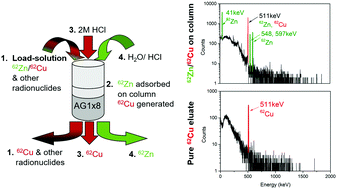Harvesting 62Zn from an aqueous cocktail at the NSCL†
Abstract
“Isotope harvesting” is a technique that offers access to exotic radionuclides created as by-products during nuclear science research. Ongoing exploratory work at the National Superconducting Cyclotron Laboratory (NSCL) is directed towards the production and extraction of rare radionuclides from a flowing-water target and intends to pave the way for future harvesting efforts at the upcoming Facility for Rare Isotope Beams (FRIB). Here we present the collection of 62Zn from an aqueous matrix irradiated with a 150 MeV per nucleon 78Kr beam, while synergistically capturing other gaseous reaction products. In addition to the production rate for 62Zn (9.08(30) × 10−5 62Zn per incoming 78Kr), the rates of formation for several other radionuclides were determined as well. The purification of 62Zn from a large number of co-produced radionuclides was performed by anion exchange chromatography, allowing the isolation of 80.5(5.2)% of the generated 62Zn. With the decay of 62Zn the radioactive daughter 62Cu is generated, and with the isolation of pure 62Cu eluate, the principle of a medical radionuclide generator could be demonstrated. To illustrate the applicability of the obtained 62Zn, the isolated product was used in free and DTPA-labelled form in a proof of principle plant uptake study with garden cress employing phosphor imaging for visualization.



 Please wait while we load your content...
Please wait while we load your content...
